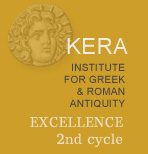Main Site . Other insciptions from the main site of Boubon
29. Honorary inscription for a (deceased) citizen.
![]()
5 |
[----------] αὐτοῦ Πολυδε[ύκους----] [ ----–--- ] καὶ ἀδελφοῦ Ο[---------] [--------μ]ητρὸς αὐτοῦ Α[-------πάν?-] [των πρωτ]ευόντων τῆς π̣[όλεως? ἐκύρω?-] [σεν ἡ βο]υλὴ καὶ ἡ πάνδη[μος ἐκκλη-] [σία τετει]μ͜ῆσθαι τὸν προδ[εδηλω-] [μένον ἀ]νδριάντι καὶ τῇ [ἀναστά-] [σει τού]του ἐν ἐπιση͜μοτ[άτῳ τόπῳ] [ὃν ἂν ὁ] πατὴ͜ρ δοκιμάσῃ. |
[-----] of his father Polydeukes [-------------] and his brother O [-------------] his mother A [------------] most distinguished in the city [------------] the council and the plenary [assembly ----- ] to honor the aforementioned [----] with a statue and [ --------] at a most distinguished [location, whichever the] father decides.
Block, found in Boubon (no further specification) by Bean and Schindler in 1966. Broken at the top. This stone is now built into the garden wall at the entrance of the Directorate of Forest Administration (Orman İşletme Şefliği) in İbecik. A few letters at the top left and left side of the stone are now damaged (underlined).
Height: 48 cm; length: 32 cm; depth (as measured by Bean and Schindler): 62 cm; letters: 2 cm (vertical stroke of the Φ: 2.2 cm).
Schindler 1972, no. 12 (pl. 1.6: squeeze); Milner 1998, p. 2, no. 1.25; BullÉp 1973, no. 456.
L. 1 : Πολυδεύκης: one of the two Dioscuri. The name is common in Attic inscriptions, it is found in Ionia and Caria, and is also attested in the Cibyratis, in Balbura and twice in Kibyra itself: IK Kibyra I 47 and 87; cf. an inscription from Karamanlı in Cibyra's territorium Milner 1998, pp. 50-52, no. 115. (But these cases hardly justify Robert's assertion, BullÉp 1973, no. 456, that the name is found "plusieurs fois à Kibyra et dans la plaine de Kibyra"). Also the other Dioscuros, Κάστωρ, is represented as a personal name in Boubon; cf. nos. 63 and 39.
L. 3-4 : Robert (loc. cit.) rejected Schindler's supplements altogether, including those he made in ll. 3-4. Robert argued that the lines must have been longer, because an adjective is needed before ἀ]νδριάντι in l. 7, and that ll. 7-8 do not make sense as restored to the small length preferred by Schindler. I believe, on the contrary, that the inscription makes perfect sense provided that the lines were in fact a little shorter than in Schindler's reconstruction. As the lettering is very regular, there is no reason why a possible reconstruction should not be proposed. For ἐκύρωσεν in ll. 4-5 (Schindler: ὥστε) cf. SEG 44 (1994), no. 1212 from Patara. In l. 4, π̣[όλεως] (cf. no. 23, l. 5) is just as plausible as π̣[ατρίδος] (Schindler; cf. no. 26, ll. 5-6).
L. 5-7 : Robert (loc. cit.) rightly rejects Schindlers restoration [ἡ βο]υλὴ καὶ ἡ πάνδη[μος ἠξίωσαν], as πάνδημος without ἐκκλησία is unattested. In ll. 6-7 Schindler provided προδεδηλου|μένον, maybe a printing error. For προδεδηλωμένος refering to the honorand, cf. IG XII, 5, 721 from the island of Andros, 1st. cent BCE.
L. 9 : The prominent role of the father in erecting the statue speaks for post mortem honors. Cf. Robert (loc. cit.).

